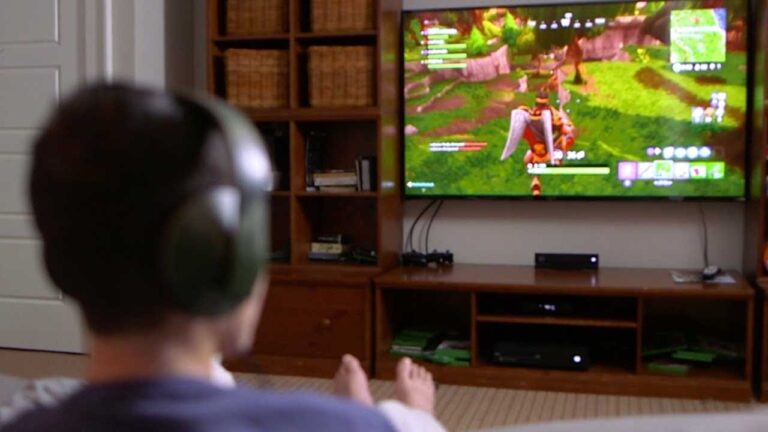
Is the allure of virtual worlds and epic quests keeping your child glued to their screen for hours on end? Are you witnessing their schoolwork suffer, their moods shift, and their real-world activities dwindle? If so, you’re likely grappling with the distressing challenge of potential Kids video game addiction in your child. You’re not alone, and more importantly, you’re not powerless.
This article provides 10 Powerful Tips to Help Your Kid Fight Video Game Addiction, offering actionable strategies and deeper insights to guide your child towards a healthier relationship with gaming. We understand the frustration and worry that comes with this issue.
Our goal is to empower you with effective, compassionate approaches that go beyond simple restrictions, fostering lasting change and helping your child rediscover the joys of a balanced life.

Understanding the Challenge of Video Game Addiction in Kids
Before diving into the solutions, it’s essential to briefly understand what video game addiction (often referred to as “gaming disorder”) entails and why children and teens can be particularly vulnerable.
It’s more than just a love for gaming; it’s characterized by impaired control over gaming, prioritizing gaming over other interests and daily activities, and continuing to game despite negative consequences.
Why are kids susceptible? Several factors contribute:
- Brain Development: Children’s and teens’ brains, especially the prefrontal cortex responsible for impulse control and decision-making, are still developing. This makes them more susceptible to the instant gratification and reward loops designed into many video games.
- Dopamine Release: Video games are expertly crafted to trigger dopamine, a neurotransmitter associated with pleasure and reward. Achievements, new levels, and unexpected loot drops create a compelling cycle that keeps them coming back for more.
- Social Connection & Escape: For many kids, games are a primary way to connect with friends. They can also offer an escape from real-world stressors, anxieties, or boredom.
- Sense of Accomplishment: Games provide clear goals and constant feedback, offering a sense of competence and achievement that might be harder to find in other areas of their lives.
Recognizing these underlying factors helps frame the challenge: you’re not just fighting a “bad habit,” but a complex interplay of developmental, psychological, and social dynamics. This understanding paves the way for more empathetic and effective interventions, which our 10 powerful tips aim to provide.
10 Powerful Tips to Help Your Kid Fight Video Game Addiction
Navigating your child’s potential video game addiction requires a multifaceted approach. These ten powerful tips are designed to equip you with practical strategies that address the issue from various angles, promoting long-term balance rather than short-term fixes.
Tip 1: Foster Open and Empathetic Communication (Not Confrontation)
The foundation of any solution is connection. Before you lay down rules, try to understand your child’s world.
- Why this is powerful: Confrontation often leads to defensiveness and rebellion. Empathy opens doors. When your child feels heard and understood, they are more likely to be receptive to your concerns and willing to collaborate on solutions.
- How to do it:
- Schedule a calm, private time to talk, free from distractions.
- Start by expressing your love and concern, using “I” statements: “I’ve noticed you seem to be spending a lot of time gaming, and I’m worried about how it’s affecting your sleep and schoolwork because I care about you.”
- Ask open-ended questions to understand their perspective: “What do you enjoy most about playing this game? How does it make you feel? What are your friends playing?”
- Actively listen without interrupting or immediately judging. Validate their feelings about the game, even if you don’t agree with the amount of time spent. “It sounds like that game is really important to you and your friends right now.”
- Pattern Interrupt: Instead of starting with what they are doing wrong, ask them what they think a healthy balance with gaming would look like for someone their age. This can lead to surprising insights.
Tip 2: Collaboratively Set Clear, Consistent, and Realistic Boundaries
Vague rules or inconsistent enforcement are recipes for conflict.
- Why this is powerful: Clear boundaries provide structure and predictability, which children need. Involving them in the process fosters buy-in and teaches self-regulation skills. Consistency ensures they understand the expectations are serious.
- How to do it:
- Discuss and Agree on Time Limits: Don’t just dictate. Talk about what constitutes reasonable playtime for weekdays versus weekends. For example, perhaps 1 hour on school nights and 2-3 hours on weekend days, but only after responsibilities are met.
- Establish “Tech-Free” Zones and Times: Make bedrooms (especially at night), mealtimes, and family gatherings screen-free. This protects sleep and encourages face-to-face interaction.
- Define Consequences (and Rewards): Clearly outline what happens if boundaries are broken (e.g., loss of gaming privileges for a day) and consider positive reinforcement for adhering to the plan (e.g., extra allowance for a non-gaming hobby).
- Write down the agreed-upon rules and post them somewhere visible. This “Family Media Agreement” can serve as a neutral reference point.
- Address Objection: “My kid will just find a way around it!” While true for some determined kids, the act of setting and discussing boundaries is still crucial for establishing expectations and opening dialogue.
Tip 3: Introduce and Actively Encourage Diverse Offline Activities
A child engrossed in video games often lacks appealing alternatives or the motivation to seek them out.
- Why this is powerful: Video games often fill a void. By helping your child discover and engage in enjoyable offline activities, you reduce the game’s allure and broaden their sources of fun, accomplishment, and social connection.
- How to do it:
- Brainstorm Interests: Talk to your child about things they used to enjoy or might be curious about – sports, music, art, drama, coding (offline projects!), volunteering, outdoor adventures, building things.
- Facilitate, Don’t Force: Offer opportunities and remove barriers. This might mean driving them to practice, paying for lessons, or inviting their friends to join.
- Make it a Family Affair: Participate in activities together. Family bike rides, board game nights, cooking sessions, or even just walks can create positive shared experiences away from screens.
- Focus on Skill-Building and Social Connection: Activities that help them build new skills or connect with peers offline can be particularly effective in combating video game addiction.
- Tweetable Quote: “Fight video game addiction by making real life more engaging than the virtual one. New hobbies, family time, outdoor fun! #ParentingTips #GamingBalance”
Tip 4: Create a “Gaming Schedule” and Prioritize Responsibilities
Instead of letting gaming happen whenever, integrate it into a structured day.
- Why this is powerful: This shifts gaming from a default activity to a planned one, teaching time management and emphasizing that responsibilities come first. It takes away the “Can I play now?” constant negotiation.
- How to do it:
- Work with your child to create a daily or weekly schedule that blocks out time for homework, chores, meals, offline activities, family time, and then designated gaming slots.
- Ensure gaming time is earned after essential tasks are completed to a satisfactory standard.
- Use visual timers or apps that can help enforce these scheduled times, giving clear warnings before gaming time is up.
- Be flexible for special occasions but firm on the general structure. This consistency is key to breaking the hold of video game addiction.
Tip 5: Understand the Game, and Even Play With Them (Occasionally)
Entering their world can provide valuable insights and build bridges.
- Why this is powerful: It shows you’re interested in their world, demystifies the game for you, and allows you to assess its content and social interactions. It can also provide natural opportunities to discuss responsible gaming.
- How to do it:
- Ask your child to explain their favorite game to you. What are the objectives? Who do they play with?
- If appropriate, ask if you can watch them play for a bit, or even try playing alongside them. This isn’t about becoming a gamer yourself, but about understanding the appeal.
- Use this shared experience to talk about sportsmanship, online safety, and how game mechanics (like loot boxes or daily rewards) are designed to keep players hooked.
- This approach can make conversations about limiting time less adversarial, as it comes from a place of shared understanding, not just disapproval.
Tip 6: Educate About the “Why” Behind Limits and Addiction Mechanics
Help your child understand the science and psychology of gaming and addiction.
- Why this is powerful: Knowledge is empowering. When kids understand how games are designed to be addictive and the impact excessive gaming can have on their brain and well-being, they are more likely to see the value in limits.
- How to do it:
- In an age-appropriate way, explain concepts like dopamine release, reward loops, and how game designers use these to keep players engaged.
- Discuss the importance of sleep for brain development, learning, and mood, and how late-night gaming disrupts this.
- Talk about the benefits of a balanced “diet” of activities for overall happiness and success.
- You can even find short, engaging videos or articles online that explain these concepts simply. This isn’t about scare tactics, but about fostering critical thinking.
Tip 7: Implement Parental Controls and Tech Tools Wisely
Technology can be part of the solution, not just the problem.
- Why this is powerful: These tools can help enforce the boundaries you’ve agreed upon, especially when willpower is low or you’re not physically present. They act as a support system for your family media plan.
- How to do it:
- Utilize built-in parental controls on gaming consoles (PlayStation, Xbox, Nintendo Switch), computers (Windows, macOS), and smartphones to set time limits, restrict access to certain games or content based on age ratings, and manage spending.
- Consider third-party apps that offer more granular control over screen time across multiple devices.
- Important: Be transparent with your child about using these tools. Explain that they are there to help everyone stick to the agreed-upon plan, not as a punishment. Combining tech tools with open communication is far more effective than covert monitoring.
Tip 8: Focus on Positive Reinforcement and Celebrate Small Wins
Acknowledge and reward effort and progress, not just perfect adherence.
- Why this is powerful: Fighting video game addiction is hard. Positive reinforcement motivates your child and makes them feel seen and appreciated for their efforts to change. It shifts the focus from punishment to encouragement.
- How to do it:
- Praise them when they stick to their gaming schedule, end a session without an argument, or choose an offline activity over gaming. Be specific: “I really appreciate how you turned off your game on time tonight without any reminders. That shows great responsibility!”
- Offer small, non-monetary rewards for consistent progress (e.g., choosing the family movie, a special outing, extra time for a preferred offline hobby).
- Celebrate milestones, no matter how small. This journey is a marathon, not a sprint.
Tip 9: Be a Role Model for Healthy Tech Use
Children learn by watching their parents.
- Why this is powerful: If you’re constantly on your phone or computer, it sends a mixed message. Modeling balanced tech use demonstrates that you practice what you preach and value offline engagement.
- How to do it:
- Be mindful of your own screen time, especially around your children.
- Adhere to the family’s tech-free zones and times yourself.
- Share your own struggles with digital distractions and how you manage them. This humanizes the issue.
- Engage in your own offline hobbies and talk about them. Show your child that a fulfilling life exists beyond screens.
Tip 10: Know When Professional Help is Needed (and Don’t Hesitate)
Sometimes, despite your best efforts, the problem is too entrenched.
- Why this is powerful: Recognizing your limits and seeking professional help is a sign of strength, not failure. Experts can provide tailored strategies and support for both your child and your family.
- How to do it:
- Consider professional help if your child exhibits severe withdrawal symptoms, their addiction is causing significant harm to their mental/physical health or academic future, they refuse to cooperate with any limits, or if you suspect underlying issues like depression, anxiety, or ADHD.
- Start by consulting your child’s pediatrician, who can offer guidance or referrals.
- Look for therapists or counselors specializing in child/adolescent behavior, gaming disorder, or behavioral addictions. Family therapy can also be very beneficial.
Beyond the Tips: Creating a Sustainable Healthy Gaming Environment
These 10 powerful tips to help your kid fight video game addiction are crucial steps, but long-term success depends on creating a sustainable environment that supports ongoing balance. This involves consistency, patience, and adapting your strategies as your child grows.
- Revisit Your Family Media Plan Regularly: As your child matures, their needs and responsibilities change. Review and adjust your agreements together every few months.
- Stay Involved and Aware: Keep the lines of communication open. Continue to show interest in their lives, both online and offline.
- Focus on Connection, Not Just Control: While limits are important, ensure your relationship with your child is primarily built on trust, love, and understanding, not just rules and restrictions.
- Remember Relapses Can Happen: If your child slips back into old habits, don’t view it as a complete failure. Use it as a learning opportunity to revisit strategies and reinforce support.
The journey to overcome video game addiction is challenging but achievable. Your consistent effort and compassionate guidance are your child’s best assets in this fight.
Conclusion: Empowering Your Child for a Balanced Digital Future
Helping your child combat video game addiction is a profound act of love and an investment in their future well-being. It’s about guiding them to harness the positive aspects of technology while avoiding its pitfalls. By implementing these 10 powerful tips with patience, consistency, and empathy, you can empower your child to develop self-control, discover a wider range of interests, and build a healthier, more balanced relationship with video games and all digital media.
The goal isn’t to eliminate gaming entirely (unless necessary in severe cases), but to integrate it into a rich and varied life where virtual achievements don’t overshadow real-world experiences and connections. You have the power to make a significant difference.
Choose ONE tip from this list to focus on implementing or improving this week. Discuss it with your partner (if applicable) and then, when ready, with your child. Small, consistent steps lead to big changes.
Frequently Asked Questions (FAQ)
How much gaming is considered “too much” for a child and potentially a sign of video game addiction?
There’s no magic number, as “too much” depends on the impact gaming has on a child’s life. However, if gaming consistently interferes with sleep, schoolwork, hygiene, family relationships, offline social activities, and mood, it’s a red flag for potential video game addiction, regardless of the exact hours. The American Academy of Pediatrics recommends consistent limits, prioritizing sleep, physical activity, and other healthy behaviors over screen time.
My child says all their friends play video games constantly. How do I combat this peer pressure when trying to fight video game addiction?
This is a common and valid concern for kids. Acknowledge their feelings: “I understand it feels like everyone is playing, and you don’t want to miss out.” Explain that your family’s rules are based on what’s healthy for them. Help them find ways to connect with friends that don’t solely revolve around excessive gaming (e.g., scheduled co-play within limits, encouraging other shared activities). One of the 10 powerful tips is to introduce diverse offline activities, which can help broaden their social circle or find peers with similar non-gaming interests.
Can a child truly “fight” video game addiction themselves, or is it all up to the parents?
Children, especially younger ones, need significant parental guidance and structure to overcome video game addiction. However, older children and teens can and should be actively involved in the process. Educating them about addiction (Tip #6), collaborating on solutions (Tip #2), and fostering their intrinsic motivation for change are key. The “fight” is a team effort, with parents providing the framework and support, and the child learning self-regulation.
What if one of these 10 powerful tips makes my child really angry or withdrawn?
It’s common for children to resist changes to their gaming habits, especially if a video game addiction is present. Anger or withdrawal can be a sign of how deeply entrenched the behavior is. If a tip leads to this reaction, first ensure you’re approaching it with empathy (Tip #1). Don’t escalate the conflict. Reiterate your concerns calmly and firmly. If the reaction is extreme or persistent, or if you feel unable to manage it, this is a strong indicator that professional help (Tip #10) might be necessary.
Are some video games more addictive than others for kids?
Yes, games with certain mechanics can be more prone to fostering video game addiction. These include:
* Games with no clear ending (e.g., many MMOs or sandbox games).
* Games that use variable reward schedules (like loot boxes or unpredictable rewards).
* Games with strong social components requiring constant participation to keep up with peers or guild activities.
* Games with frequent updates, events, or daily login bonuses that create a sense of urgency or FOMO.
Understanding the type of game your child plays can be helpful when implementing strategies.






